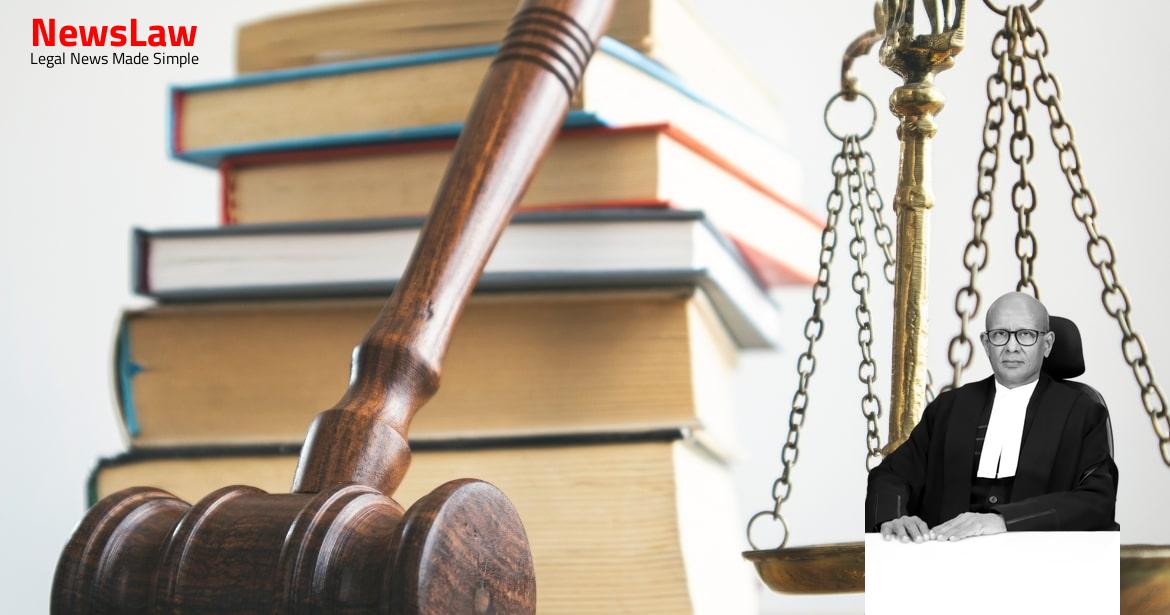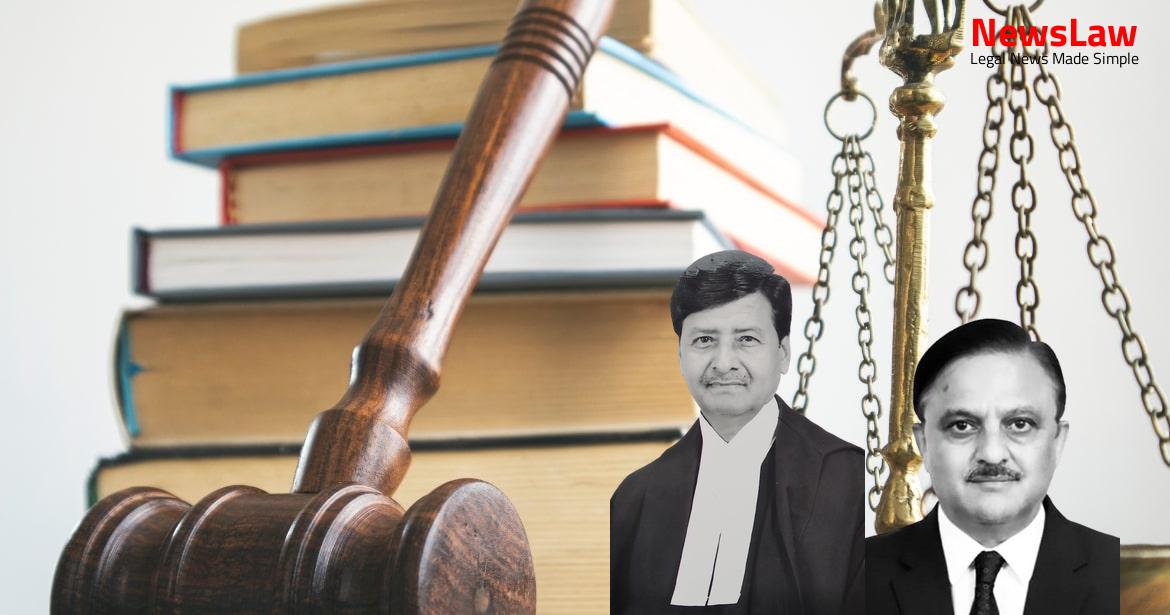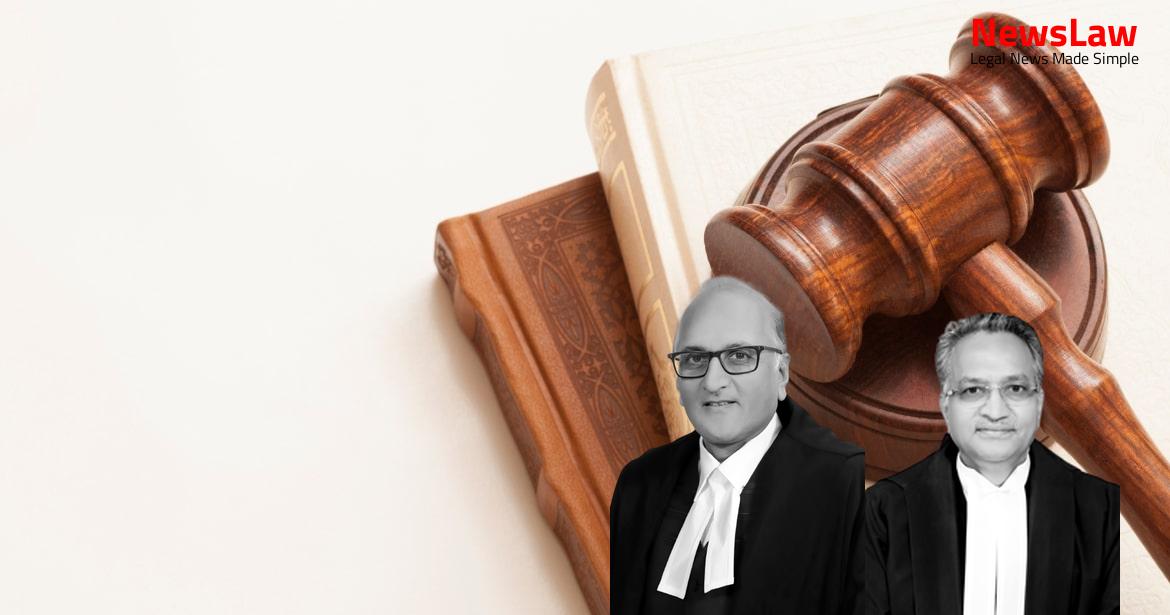In a brief outline, it could be noticed that in this case, the appellant has been convicted of the offence of murder of her five-year-old child in the house of her mother-in-law at Perambalur in the morning of 21.06.2007. It was alleged that the appellant was last seen with the child and after having killed the child, when her mother-in-law and other witnesses reached the scene of crime, she ran away and was apprehended in the late afternoon at Perambalur New Bus Stand. In this appeal, the concurrent findings of the two Courts have been questioned essentially with reference to certain discrepancies in the version of the prosecution witnesses and on the ground that the prosecution has failed to establish a chain of cogent circumstances which could lead to the only hypothesis that the appellant had killed her own child. As my grand daughter is 5 years old, my son had spoken from Riyat to Kolakkudi and said that she has to go to Perambalur and 4 stay in my house and educate the child. As I had warned her not to go to Kolakkudi, she was telling that only because of this child, I could not live peacefully. By that time, my daughter Mumtaz and my daughter-in-law Asha came to see me.
Besides, holding my grandchild’s neck with the saree and killing her, she had pushed us and ran away through the entrance. As per the post-mortem report (Ex. It was alleged that after her arrest, the appellant identified the saree by which the child was strangulated; that the saree allegedly carrying blood-stains was seized in the presence of attesting witnesses; and that following her arrest, the appellant made a confessional statement that was recorded by PW-12 in the presence of witnesses. Four other witnesses, PW-2 Mumtaz, daughter of PW-1; PW-3 Asha Begum, other daughter-in-law of PW-1; PW-4 Sharfunisha, landlord of PW-1; and PW-5 Thiru-Jothi, neighbour of PW-1 were claimed to be the witnesses who reached the scene of crime immediately after the occurrence.
She further stated that Abdul Raheem had called her to say that his daughter should be admitted in a school in Perambalur and he would 7 send her money for that purpose; and subsequently, on 18.06.2007, PW-62007 Jamal Mohammed, father of the appellant, dropped the appellant and the child to the house of PW-1 with request to educate the child in Perambalur since Abdul Raheem was allegedly not sending the appellant any money. My daughter-in- law’s father was telling his daughter, the margin accused, that on the next day, 19 he would be leaving to his village and she has to take care of everything. For that the margin accused said that no need of getting meat, and gave me Rs.100/- and asked me to get idli. The said information was given to me by my daughter Mumtaz on the way to home after getting the idli, as the house of 8 my daughter Mumtaz is situated on the way….. I told the details given by Mumtaz to me and asked her to wake up grand daughter and give her the tea. When I was telling the accused that she is telling lie once again, my daughter Mumtaz and my middle daughter-in-law Asha Begum both of them came into my house.
Also Read: https://newslaw.in/case-type/civil/courts-analysis-on-bona-fide-requirement-in-eviction-petitions/
But again the accused said that she had killed the child, I shook the head of my grand daughter. When I saw that my grand daughter was dead and came out shouting, as said by me earlier, my daughter Mumtaz, my middle daughter-in- law Asha begum came there. After the police authorities came, seeing that the child was dead, the police authorities brought me and the margin accused, my daughter-in-law to the police station. It is incorrect to state that I had not deposed during the police investigation that after making the tea and giving it to my daughter- in-law the margin accused gave me Rs.100/- to get idli and that I went to the farmer’s market to get the idli and when I got the idli and was coming back, through my daughter Mumtaz she said that Abdul Raheem spoke to my daughter Mumtaz over phone.
It is incorrect to state that in the event that my son Abdul Raheem and the accused did not take care of me, they had handed over my grand daughter Farhana to me. By that time, along with my mother, the margin accused and her daughter were staying when they came to Perambalur. The accused and her daughter were residing in my mother’s house separately.
My younger brother Abdul Raheem told me over phone that I have to tell the accused to admit the school in Perambalur and to stay along with my mother. When my mother got idli and came back, I told the details as said by my younger brother, Abdul Raheem over phone. When I went and saw and asked the accused, the accused was silent and this had been deposed by me in the chief examination and the same had not been deposed during the investigation by the police authorities. After my mother-in-law got the idli, when she shouted, I and my sister-in-law Mumtaz went to the house of my mother-in-law. Two days before the death of Farhana, the accused came with her child to our house. After she came, she asked my husband that the husband of the margin accused Abdul Raheem is not sending money to her and that he is also not calling her over phone, and that she wanted to educate her child Farhana. PW-4 Sharfunisha, the landlord of PW-1, deposed that when she came back to her house, she saw the child with the appellant. It is incorrect to state that I did not depose during the police investigation that I went to send my child to school and after sending my child, when I came back, I saw the crowd in my house. Only on the date of the death of the accused’s child, I had seen the margin accused when she was sitting near the dead body of the child in the house wherein witness Basheera was staying. Cross-examination: It is incorrect to state that I had not deposed the details as mentioned in the chief examination, during the police 13 investigation. During cross-examination, he deposed that the wound would be more than 2 cm if a saree was tied around the neck. During cross-examination, she clarified that PW-1 had not deposed in her original complaint that she had come out of her house and shouted after realising that the child was dead and had not brought the appellant to the police station immediately after the occurrence. … The witness Basheera did not depose in the complaint that after seeing that the child was dead, Basheera came out of the house, and shouted and thereafter the witnesses Mumtaz and Asha Begum came there.
If it is said that at that time, I had taken the margin accused along with the above said witnesses, it is also incorrect… ” 15 5.8.
He also stated to have arrested the appellant at Perambalur New Bus Stand and having recorded her confessional statement in the presence of witnesses. As per the confession statement, the saree which she was wearing was seized by me with the assistance of the lady police under the mahazar. Cross-Examination:
Also Read: https://newslaw.in/case-type/criminal/analysis-of-evidence-and-courts-ruling/
In Ex.P8 Mahazar, it had been indicated that through the Sub-Inspector, Subbulakshmi the accused was given the alternate saree. It is incorrect to state that after the death of the child the margin accused had ran away from the house and that we had published the news falsely stating that the margin accused was lying near the deceased child.
It is incorrect to state that on 21.6.07, the accused who was in Kolakkudi village had the information that her child was dead and that she came to Perambalur by bus and when she got down, I had arrested her….” 9. On 16.6.2007, I had called Shamsudeen who came from foreign country over phone. When I started to go to the village, my son-in- law’s mother asked me to leave her grand daughter Farhana alone and take my daughter along with me. If it is said that I had deposed during police investigation, that my daughter margin accused used to tell me that she is going to mother-in- law’s house and hospital, and was going in a wrong way, it is not correct. If it is said that during the police investigation, I had deposed that my son-in-law who came to know all these details, had called over phone and told me to drop the margin accused and his child in the house of witness Basheera, they are all incorrect. The Trial Court held that although PW-1 to PW-3 were related witnesses but, PW-4 and PW-5 were independent witnesses who had seen the child and the accused-appellant together; and there was no necessity for them to depose against the appellant. After finding that the appellant was the last person to be seen with the victim child, as established by the testimony of PW-1 to PW-5, the Trial Court highlighted the importance of cogent evidence establishing the chain of circumstances; and held that the prosecution had discharged its burden of proving beyond reasonable doubt that the appellant had committed the offence of murder of the victim child. in the house of P.W.1, when P.W.1 was not available at house, she had twisted outer end of her saree and strangled around the neck of her daughter 6 years old Farhana, who was sleeping and the thyroid cartilage bone was fractured and thus caused the death. While accepting the submissions that there had been certain inconsistencies in the statements made by PW-1, the High Court held that the only point for consideration was as to whether the child was left in the custody of the appellant at the time of occurrence; and after detailed examination of the evidence on record, affirmed the findings of the Trial Court that the appellant was the last person seen with the deceased child. No learned counsel brought to the notice of this Court that according to P.W.1, when she was returning from the house, she found that the accused was strangulating the child, which was not available in 161 statement.
Thirdly, the accused was the only person available with her child at the place and time of occurrence and it is for the accused to explain as to how the occurrence had taken place. Assailing the judgment and order aforesaid, learned counsel for the appellant has put forward a variety of submissions, particularly assailing the findings in question with reference to several discrepancies appearing in the prosecution case; the factum of strained relations between the husband of the appellant and PW-1 to PW-3 for which, they might be interested in deposing against the appellant; the plea of alibi of the appellant, particularly with reference to the testimony of PW-6 Jamal Mohammed; and no likelihood of motive for the appellant to kill her own child.
Further, with respect to the statement of PW-6, learned counsel has argued that plea of alibi taken by the appellant is clearly established on record and looking to the background facts, particularly the strained relations of the appellant with her mother-in-law and other relatives of her husband, the plea of alibi and assertion of PW-6 that he and the appellant left the child in the company of PW-1 and her relatives cannot be ignored. It has also been submitted that in view of the admitted fact that there were strained relations between husband of the appellant and PW-1, possibility of the appellant being falsely implicated so that PW-1 could derive monetary benefit from her son, husband of the appellant, cannot be ruled out. State of Chhattisgarh : (2012) 4 SCC 257 as regards entitlement of the accused to maintain silence in examination under Section 313 CrPC; and obligation on the part of the Trial Court to put the material evidence to the accused to extend an opportunity of explanation. Learned counsel has argued that minor discrepancies in the statements of witnesses have no effect on the prosecution case, and that presence of the appellant alone with the child has been corroborated by the testimony of independent witnesses. The appellant was required to furnish some explanation under Section 313 CrPC but she did not do so, leaving no room for doubt that she was responsible for the death of the child. The learned counsel for the respondent-State has also countered the argument that PW-1 to PW-3 were biased witnesses by submitting that in the instant case, there was no reason to falsely implicate the appellant or protect the real culprit. Thus, learned counsel for the respondent-State would submit that when duly established chain of circumstances leads to no other plausible hypothesis than the guilt of the appellant, no case for interference in the concurrent findings of the Trial Court and the High Court is made out. In such an appeal by special leave, where the trial court and the High Court have concurrently returned the findings of fact after appreciation of evidence, each and every finding of fact cannot be contested nor such an appeal could be dealt with as if another forum for reappreciation of evidence. Of course, if the assessment by the trial court and the High Court could be said to be vitiated by any error of law or procedure or misreading of evidence or in disregard to the norms of judicial process leading to serious prejudice or injustice, this Court may, and in appropriate cases would, interfere in order to prevent grave or serious miscarriage of justice but, such a course is adopted only in rare and exceptional cases of manifest illegality.
It is only in rare and exceptional cases where there is some manifest illegality or grave and serious miscarriage of justice on account of misreading or ignoring material evidence, that this Court would interfere with such finding of fact. The principles explained and enunciated in the case of Sharad Birdhichand Sarda (supra) remain a guiding light for the Courts in regard to the proof of a case based on circumstantial evidence. A close analysis of this decision would show that the following conditions must be fulfilled before a case against an accused can be said to be fully established: ( 1 ) the circumstances from which the conclusion of guilt is to be drawn should be fully established. These five golden principles, if we may say so, constitute the panchsheel of the proof of a case based on circumstantial evidence. Horry [1952 NZLR 111] thus: “Before he can be convicted, the fact of death should be proved by such circumstances as render the commission of the crime morally certain and leave no ground for reasonable doubt: the circumstantial evidence should be so cogent and compelling as to convince a jury that upon no rational hypothesis other than murder can the facts be accounted for.” 156. It is only when such omissions amount to a contradiction creating a serious doubt about the truthfulness or creditworthiness of the witness and other witnesses also make material improvements or contradictions before the court in order to render the evidence unacceptable, that the courts may not be in a position to safely rely upon such evidence. In that case the finding of guilt concurrently recorded by the Trial Court and the High Court was challenged mainly on the ground of minor discrepancies in the evidence for which, this Court emphasised that excessive importance cannot be attached to such minor discrepancies. It is a pure finding of fact recorded by the Sessions Court and affirmed by the High Court. The finding of guilt recorded by the Sessions Court as affirmed by the High Court has been challenged mainly on the basis of minor discrepancies in the evidence. The reasons are obvious: “(1) By and large a witness cannot be expected to possess a photographic memory and to recall the details of an incident. ( 7 ) A witness, though wholly truthful, is liable to be overawed by the court atmosphere and the piercing cross-examination made by counsel and out of nervousness mix up facts, get confused regarding sequence of events, or fill up details from imagination on the spur of the moment. Normal discrepancies in evidence are those which are due to normal errors of observation, normal errors of memory due to lapse of time, due to mental disposition such as shock and horror at the time of occurrence and those are always there however honest and truthful a witness may be.
As regards the approach towards the appreciation of the evidence of closely related witnesses, in the case of Gangabhavani (supra), this Court has explained the principles as follows: – “15….. The accused may choose to maintain silence or complete denial even when his statement under Section 313 CrPC is being recorded, of course, the court would be entitled to draw an inference, including adverse inference, as may be permissible to it in accordance with law. The principles enunciated by this Court in regard to the obligation of explanation in terms of Section 106 of the Evidence Act and the consequences of want of explanation have been explained by this Court in the case of Satpal (supra) as follows: – “ 6. If the accused offers no explanation, or furnishes a wrong explanation, absconds, motive is established, and there is corroborative evidence available inter alia in the form of recovery or otherwise forming a chain of circumstances 35 leading to the only inference for guilt of the accused, incompatible with any possible hypothesis of innocence, conviction can be based on the same.
Also Read: https://newslaw.in/case-type/civil/validity-of-tamil-nadu-land-acquisition-acts/
State of Uttarakhand : (2022) 5 SCC 438, where the prosecution failed to prove the basic facts as against the accused, this Court emphasised that Section 106 of the Evidence Act does not relieve the prosecution of its primary duty to prove the guilt of the accused as follows: – “ 19. Moreover, in a case based on circumstantial evidence, whenever an incriminating question is posed to the accused and he or she either evades response, or offers a response which is not true, then such a response in itself becomes an additional link in the chain of events.” As per the version of the witnesses PW-1, PW-2 and PW-3, who supported the prosecution case as also as per the version of PW-6 Jamal Mohammed, father of the appellant, who did not support the prosecution case and was declared hostile, this much remains indisputable that on 18.06.2007, the appellant came with her father and with her daughter to Perambalur from Kolakkudi. According to PW-6 Jamal Mohammed, the appellant was not in Perambalur at the relevant point of time; and she came to Perambalur with him on 21.06.2007 in the late afternoon after receiving information about demise of the child and thereafter, she was arrested. Apart from the fact that PW-1, PW-2 and PW-3 consistently maintained their versions that the appellant was available at the time and place of incident, two independent witnesses, PW- 4 Sharfunisha, landlord of PW-1 and PW-5 Thiru-Jothi, neighbour of PW-1 testified that they saw the appellant sitting with or near the body of the deceased child immediately after, and at the place of, the incident. Another major factor highlighted and elaborated by the learned counsel for the appellant relates to certain discrepancies appearing in the versions of PW-1 Basheera, as stated in the complaint made to the police compared with her assertions before the Court.
The first discrepancy in the matter is that, as per the version in the complaint, she left her house in the morning to buy idli without taking money, but in her deposition, she stated that appellant gave her Rs. Further, the said 40 witness PW-1 seems to have obviously lost the track of facts when she asserted in her deposition that the appellant was taken to the police station after the incident. The other witnesses who had reached the scene of crime including the independent witnesses PW-4 and PW-5 have consistently maintained that the appellant was available with the dead body of the child at the place of, and immediately after, the incident.
PW- 8 also opined that if outer end of the saree was twisted and put around the neck and the person was strangled, there was a chance of such a wound. Other way round, if at all the appellant considered him to be a material witness, nothing prevented her from making a prayer to the Court for his examination and nothing prevented her from making specific submissions in that regard during her examination under Section 313 CrPC. Even if it be taken that there was a quarrel of the appellant with her mother-in-law (PW-1) in the morning of the date of incident because the appellant wanted to go the place of her father, it cannot be said that such a quarrel would make it a case of grave and sudden provocation. ………………………… J.
Case Title: VAHITHA Vs. THE STATE OF TAMIL NADU (2023 INSC 151)
Case Number: Crl.A. No.-000762-000762 / 2012



